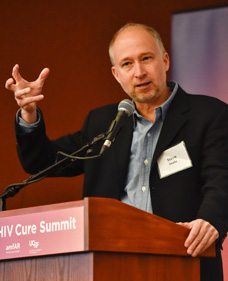 Steven Deeks, M.D.amfAR’s “Countdown to a Cure for AIDS” research initiative—aimed at developing the scientific basis of a cure by 2020—is predicated on four parts of an acronym: C-harting the location of the persistent virus reservoir; U-nderstanding how it is maintained; R-ecording how much virus it holds; and, ultimately, E-liminating that reservoir. Writing in the August issue of the journal PLOS ONE, amfAR-funded scientist Steven Deeks of the University of California, San Francisco sought to approach the “R” aim.
Steven Deeks, M.D.amfAR’s “Countdown to a Cure for AIDS” research initiative—aimed at developing the scientific basis of a cure by 2020—is predicated on four parts of an acronym: C-harting the location of the persistent virus reservoir; U-nderstanding how it is maintained; R-ecording how much virus it holds; and, ultimately, E-liminating that reservoir. Writing in the August issue of the journal PLOS ONE, amfAR-funded scientist Steven Deeks of the University of California, San Francisco sought to approach the “R” aim.
Together with colleagues from seven other institutions—the universities of Montreal, Melbourne, Sydney, Pennsylvania, San Diego, Johns Hopkins, and the National Institutes of Health—Deeks studied 51 HIV-infected subjects who had been on effective antiretroviral therapy (ART) for an average of nine years. He took clues from “the Berlin patient,” who was cured of HIV through a bone marrow transplant from a donor resistant to HIV infection, as well as from “HIV controllers,” people who can maintain very low levels of virus without ART. All of these individuals have very low levels of antibodies to HIV.
The investigators compared five different measures of the HIV reservoir, including HIV RNA and viral DNA, to the strength and specificity of antibodies against a wide range of HIV proteins in the 51 donors. Not content with simply sampling the subjects’ blood, they also looked at virus that lay dormant in their intestinal tissue. The good news is that two important leads were found: antibody responses to the HIV integrase protein tracked well with HIV RNA in the gut and antibody responses to the HIV matrix protein tracked well with viral DNA. These are key indicators of all dormant HIV, including replication-competent and –incompetent virus. The bad news is that they hadn’t studied enough people to prove statistically that these findings are accurate. More work is needed with larger numbers of individuals.
This is an important endeavor as without a sensitive, reliable measure of the size of the HIV reservoir, it will be difficult to evaluate strategies aimed at a cure.
Dr. Laurence is amfAR’s senior scientific consultant.